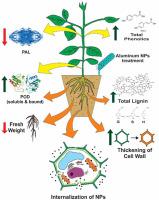Plant Physiology and Biochemistry ( IF 6.1 ) Pub Date : 2020-12-31 , DOI: 10.1016/j.plaphy.2020.12.028 Guilherme Henrique Gonçalves de Almeida 1 , Rita de Cássia Siqueira-Soares 1 , Thatiane Rodrigues Mota 1 , Dyoni Matias de Oliveira 1 , Josielle Abrahão 1 , Marcela de Paiva Foletto-Felipe 1 , Wanderley Dantas Dos Santos 1 , Osvaldo Ferrarese-Filho 1 , Rogério Marchiosi 1

|
Aluminum oxide (Al2O3) nanoparticles (NPs) are among the nanoparticles most used industrially, but their impacts on living organisms are widely unknown. We evaluated the effects of 50–1000 mg L-1 Al2O3 NPs on the growth, metabolism of lignin and its monomeric composition in soybean plants. Al2O3 NPs did not affect the length of roots and stems. However, at the microscopic level, Al2O3 NPs altered the root surface inducing the formation of cracks near to root apexes and damage to the root cap. The results suggest that Al2O3 NPs were internalized and accumulated into the cytosol and cell wall of roots, probably interacting with organelles such as mitochondria. At the metabolic level, Al2O3 NPs increased soluble and cell wall-bound peroxidase activities in roots and stems but reduced phenylalanine ammonia-lyase activity in stems. Increased lignin contents were also detected in roots and stems. The Al2O3 NPs increased the p-hydroxyphenyl monomer levels in stems but reduced them in roots. The total phenolic content increased in roots and stems; cell wall-esterified p-coumaric and ferulic acids increased in roots, while the content of p-coumaric acid decreased in stems. In roots, the content of ionic aluminum (Al+3) was extremely low, corresponding to 0.0000252% of the aluminum applied in the nanoparticulate form. This finding suggests that all adverse effects observed were due to the Al2O3 NPs only. Altogether, these findings suggest that the structure and properties of the soybean cell wall were altered by the Al2O3 NPs, probably to reduce its uptake and phytotoxicity.
中文翻译:

氧化铝纳米粒子影响细胞壁结构和木质素组成,轻微改变大豆生长
氧化铝 (Al 2 O 3 ) 纳米颗粒 (NP) 是工业上最常用的纳米颗粒之一,但它们对生物体的影响却鲜为人知。我们评估了50–1000 mg L -1 Al 2 O 3 NPs对大豆植物生长、木质素代谢及其单体组成的影响。 Al 2 O 3 NPs不影响根和茎的长度。然而,在微观水平上,Al 2 O 3 NPs改变了根部表面,导致根尖附近形成裂纹并损坏根冠。结果表明,Al 2 O 3 NPs被内化并积累到根部的细胞质和细胞壁中,可能与线粒体等细胞器相互作用。在代谢水平上,Al 2 O 3 NPs增加了根和茎中可溶性和细胞壁结合的过氧化物酶活性,但降低了茎中苯丙氨酸解氨酶活性。在根和茎中也检测到木质素含量增加。 Al 2 O 3 NPs增加了茎中的对羟基苯基单体水平,但降低了根中的对羟基苯基单体水平。根、茎中总酚含量增加;根中细胞壁酯化的对香豆酸和阿魏酸含量增加,而茎中对香豆酸含量减少。在根中,铝离子 (Al +3 ) 的含量极低,相当于以纳米颗粒形式施用的铝的 0.0000252%。这一发现表明观察到的所有不利影响均仅归因于 Al 2 O 3 NP。 总而言之,这些发现表明,Al 2 O 3 NPs改变了大豆细胞壁的结构和特性,可能是为了减少其吸收和植物毒性。











































 京公网安备 11010802027423号
京公网安备 11010802027423号